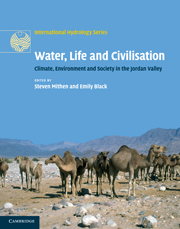Book contents
- Frontmatter
- Contents
- List of figures
- List of tables
- List of contributors
- Acknowledgements
- 1 Introduction: an interdisciplinary approach to Water, Life and Civilisation
- Part I Past, present and future climate
- Part II The palaeoenvironmental record
- Part III Hydrological studies of the Jordan Valley
- Part IV Human settlement, climate change, hydrology and water management
- 14 The archaeology of water management in the Jordan Valley from the Epipalaeolithic to the Nabataean, 21,000 BP (19,000 BC) to AD 106
- 15 From global climate change to local impact in Wadi Faynan, southern Jordan: ten millennia of human settlement in its hydrological context
- 16 Palaeoenvironmental reconstruction at Beidha, southern Jordan (c. 18,000–8,500 BP): Implications for human occupation during the Natufian and Pre-Pottery Neolithic
- 17 The influence of water on Chalcolithic and Early Bronze Age settlement patterns in the southern Levant
- 18 Modelling water resources and climate change at the Bronze Age site of Jawa in northern Jordan: a new approach utilising stochastic simulation techniques
- 19 A millennium of rainfall, settlement and water management at Humayma, southern Jordan, c. 2,050–1,150 BP (100 BC to AD 800)
- Part V Palaeoeconomies and developing archaeological methodologies
- Part VI Society, economy and water today
- Part VII Conclusions
- Index
- Plate section
- References
17 - The influence of water on Chalcolithic and Early Bronze Age settlement patterns in the southern Levant
from Part IV - Human settlement, climate change, hydrology and water management
Published online by Cambridge University Press: 26 April 2011
- Frontmatter
- Contents
- List of figures
- List of tables
- List of contributors
- Acknowledgements
- 1 Introduction: an interdisciplinary approach to Water, Life and Civilisation
- Part I Past, present and future climate
- Part II The palaeoenvironmental record
- Part III Hydrological studies of the Jordan Valley
- Part IV Human settlement, climate change, hydrology and water management
- 14 The archaeology of water management in the Jordan Valley from the Epipalaeolithic to the Nabataean, 21,000 BP (19,000 BC) to AD 106
- 15 From global climate change to local impact in Wadi Faynan, southern Jordan: ten millennia of human settlement in its hydrological context
- 16 Palaeoenvironmental reconstruction at Beidha, southern Jordan (c. 18,000–8,500 BP): Implications for human occupation during the Natufian and Pre-Pottery Neolithic
- 17 The influence of water on Chalcolithic and Early Bronze Age settlement patterns in the southern Levant
- 18 Modelling water resources and climate change at the Bronze Age site of Jawa in northern Jordan: a new approach utilising stochastic simulation techniques
- 19 A millennium of rainfall, settlement and water management at Humayma, southern Jordan, c. 2,050–1,150 BP (100 BC to AD 800)
- Part V Palaeoeconomies and developing archaeological methodologies
- Part VI Society, economy and water today
- Part VII Conclusions
- Index
- Plate section
- References
Summary
ABSTRACT
While the environment cannot be considered a ‘deus ex machina’ for any event in human history, it is becoming increasingly clear to prehistorians that the extraordinary developments in human social complexity documented in the archaeological record since the beginnings of sedentism in the Late Pleistocene occurred in concert with profound climatic and environmental changes. This chapter investigates settlement patterns in Jordan, Palestine and Israel during a key archaeological transition in the southern Levant, the Chalcolithic to the Early Bronze Age (EBA). We summarise regional settlement location in relation to potential forcing factors which themselves may be indicative of societal and climatic change, such as springs, wadis, routes and permanent sites. We make a geospatial analysis and calculate ‘cost distance’ values between these forcing factors and the settlement data. We then analyse how these cost distance values change over time in different altitudinal belts. We find that the cost distance patterns varied at different altitudes during the transition period. In some altitudinal belts in the EBI and EBA, springs appear to determine settlement location, showing the importance of climate, while in other altitudinal belts formalisation of settlements around the longer-standing sites and routes suggest that socio-political changes may have been more influential in the EBA. The value of this method and the implications of our results are then discussed in the light of existing and emerging research on the transition from the ‘prehistoric’ to the ‘historic’ period.
- Type
- Chapter
- Information
- Water, Life and CivilisationClimate, Environment and Society in the Jordan Valley, pp. 269 - 288Publisher: Cambridge University PressPrint publication year: 2011
References
- 3
- Cited by

